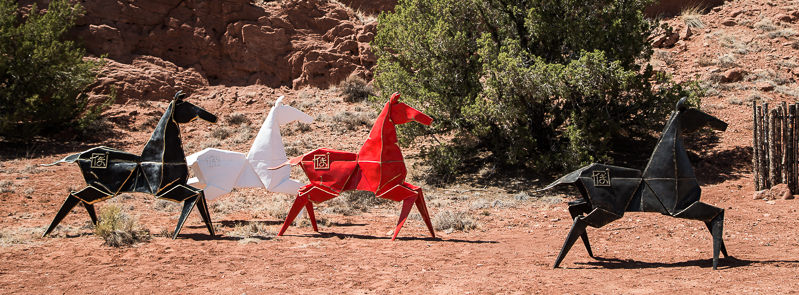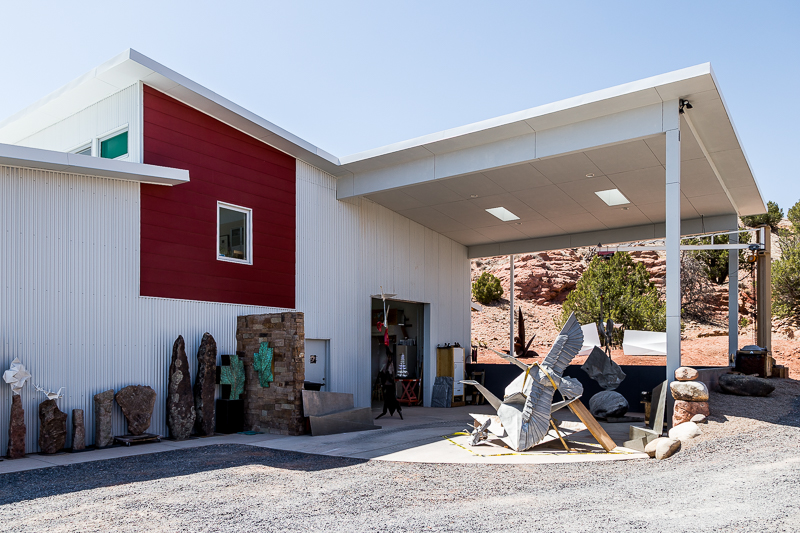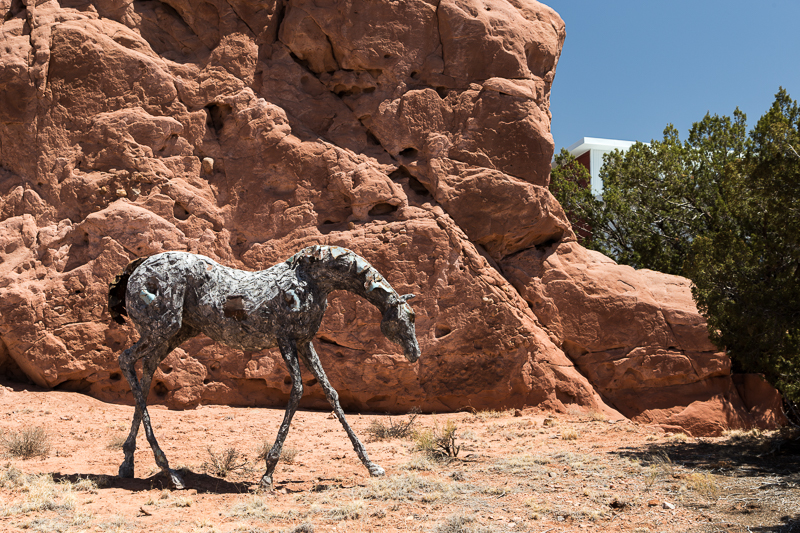Guest Blog: Modern Architecture and Design Society (MA+DS)
Sculptor Kevin Box and his wife and collaborator Jennifer Box created an eco-friendly home and studio Santa Fe, New Mexico. We talked to him about his studio, and captured some amazing images of his modern sculpture based on the ancient art of origami. His latest project is “Origami in the Garden,” a traveling installation of Kevin’s large-scale work in gardens across North America.

Your home and studio were planned and conceived with the Frank Lloyd Wright School of Architecture. What ideas for the home stuck from the planning stages to completion?
Definitely the siting of the building (which is one of the most important features), the breezeway between the home and studio as well as the aesthetic approach. The “Chaco Canyon meets mid century modern” aesthetic was their idea. Dry stack stone walls (ancient look) with a modern building added later was the concept. We also used a lot of sustainable/efficient techniques that I was introduced to at Taliesin West. More than anything is the master plan. We organized design charrettes with local stakeholders to find out what was missing and what we could add to the Turquoise Trail National Scenic Byway.
We integrated Santa Fe County development directors, the Turquoise Trail Corridor Management Plan and the San Marcos Community Plans to establish a long-term vision that realized the maximum potential of the property while retaining the character of residential zoning. That is a mouthful but the big picture includes a studio residency program for artists of all nature. We have not realized all of that yet, but it is possible. And it is all written down in the “Master Plan” that Taliesin developed. I have been told it is ambitious, but look at what we have already accomplished in the six years since its completion!
What can you tell us about the sustainable features of the home?
I started out with the goal of an energy efficient building because it directly affects the operating costs. According to Santa Fean Ed Mazria, 30% +/- of our energy resources are used up by our buildings. As a sculptor, I already have a large carbon footprint and a random income stream, so I wanted our home/studio to offset carbon while controlling our overhead. I audited classes at Taliesin and took continuing education courses at the Santa Fe Community College on green building techniques to learn more about how to achieve my goals.

Dahl Plumbing and National Plumbing of Santa Fe were integral in designing an efficient heating and cooling system using a Geothermal Ground Source Heat Pump. We used half of the Geothermal system that was estimated because of the insulation, passive solar design and thermal mass (solid concrete walls included inside the housing envelope). In fact, on startup, the house went from zero to 70 degrees in just six hours (the engineers estimated at least 12-24 hours)! Insulating under the slab contributed greatly to this as well as blown in recycled paper insulation in the walls with an additional 2″ of foam on the exterior walls. This translates to an electric-only house with no need for rural propane services. (The building utilizes a 9.8 kW PV solar array that offsets almost all of our dependency on coal-powered electricity.) We get 7 degrees of free heat on a sunny winter day, and the windows are shaded in the summer.
Autotroph Architecture of Santa Fe helped us achieve this by using a 3-D modeling system that enabled us to adjust every window and eve to ensure proper orientation throughout the seasons. Our electric consumption for 3,800 sq. ft. has averaged out to around $250 per month and that includes my shop with air compressors, computers, welding, grinding and other high load equipment. Sky lighting and windows ensure natural light everywhere except for one bathroom and the mechanical room. We are slowly trading out the incandescent bulbs with LED.
Low flow toilets and on-demand hot water ensure that we use only what we need from our well. But New Mexico has some progressive septic design options for what we do use. Raincatcher Inc. of Santa Fe designed a “Pummice Wick” system that enables us to re-use 100% of our wastewater for irrigation. The result is green spaces around the house that contribute to cooling in the summer, ground stabilization and dust reduction.
Durable exterior materials were chosen primarily to reduce maintenance. Our high altitude UV exposure means wood doesn’t last out here and stucco is notorious for cracking and patching. Factory painted metal, compressed concrete board and stone means less maintenance as well as fire resistance.
The home is on a very unique site along the edge of the Galisteo Basin known as the Garden of the Gods. Why did you choose it?
To be honest it chose me. The woman who owned it prior had never put it on the market for fear of it getting into the wrong hands. I met her while visiting a friend in her guesthouse. We were introduced and it was one of those “woo-woo” moments where she just announced to everyone that I was “the one” for this special piece of property she owned. I had no idea or interest in whatever property she was talking about until a year later when I found myself engaged to be married and relocating to Santa Fe. I tracked her down because I was looking for 5 acres to build a studio on. When I found her living in another state, I asked if she remembered me and she said, “of course, you are the one.” She said I had to take all 35 acres and that she would reduce the price and work with me in any way she could to help me own it. Once I walked the property, I realized how special it was and began figuring out how to take her up on this once in a lifetime opportunity.
Tell us a little about the sculpture garden and its relation to the home and site.
Sculptures take up a lot of space. Not just the pieces themselves but the equipment and the creative process. Integrating a studio workshop requires space, and space is what this place has. I also realized early on that everyone wanted to get in and walk around. The highway dept. built a scenic pullout on the property years ago. People were constantly parking there and trespassing at will. I wanted to keep it accessible but in a respectful way. A sculpture garden with walking paths was a natural solution to both problems!
I have plenty of space off the highway behind the rocks to live, build my work and spread out of site. Finished pieces awaiting installation or final steps can hang out in the sculpture garden. The two compliment each other. The great thing about the landscape is that I don’t have to do anything to it to maintain it. I just made some paths and leave it alone. The landscape itself is spectacular, I have never seen a sculpture garden with such dramatic landscaping.

What else should people know about your home and sculpture garden?
We have spent seven years planning and building into this place. I have listened to everyone who had something to say about what we have been doing. Everything I have described takes you down another rabbit hole of experience. If you are into architecture it is there, if you are into art it is there, if you are into history it’s there, if you are into the landscape, it is there. There is something for everybody.
The Modern Architecture + Design Society produces architecture and design events across North America.
